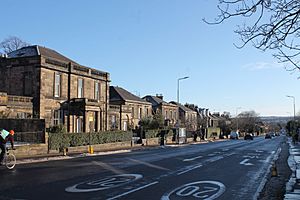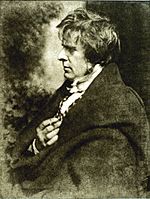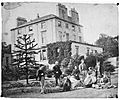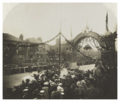Newington, Edinburgh facts for kids
Quick facts for kids Newington |
|
|---|---|
 Minto Street, looking south |
|
| Population | 11,130 |
| Council area | |
| Lieutenancy area | |
| Country | Scotland |
| Sovereign state | United Kingdom |
| Post town | EDINBURGH |
| Postcode district | EH8 |
| Postcode district | EH9 |
| Dialling code | 0131 |
| Police | Lothian and Borders |
| Fire | Lothian and Borders |
| Ambulance | Scottish |
| EU Parliament | Scotland |
| UK Parliament |
|
| Scottish Parliament |
|
Newington is a neighbourhood of southern Edinburgh, Scotland. Developed from the early 19th century, it is an affluent, predominantly residential area.
Located between 1 (1.5km) and 2.5 miles (4km) south of Edinburgh city centre, Newington is bounded to the east by St Leonard's and Prestonfield; to the south by Cameron Toll and Nether Liberton; to the west by Blackford, the Grange, and Sciennes; and to the north by the Southside, Edinburgh. Historically part of the parishes of St Cuthbert's and Liberton in the county of Midlothian, Newington was incorporated into the city of Edinburgh between 1832 and 1896.
Originally part of the ancient forest of Drumselch, the lands of Newington were feued by the town council of Edinburgh from 1586. Aside from small developments, the area was predominantly rural until Benjamin Bell purchased the lands in 1805 and began to develop them as a suburb. Around this time, the construction of a new route from Edinburgh's New Town to Liberton via Newington was accelerating the southward development of the city. From the 1850s, bus services connected Newington to the city centre while trams arrived in 1871. Newington station opened to passengers in 1884. By this time, the area was almost enitrely developed. In the latter half of the 19th century, institutions including the Longmore Hospital, the Royal Blind Asylum, and St Margaret's School set up in Newington. Newington station closed to passengers in 1962.
Northern Newington consists of dense early Victorian tenements and Georgian terraces. South of Salisbury Road, these give way to sparser, late Georgian and early Victorian developments, some of which were founded as gated communities. Southern Newington includes Victorian villas and terraces as well as some former industrial buildings.
With a population of around 11,000, Newington today remains an affluent, primarily residential suburb. The area is also one of the most diverse in Edinburgh. Newington houses Edinburgh's only synagogue as well as the headquarters of Historic Environment Scotland and the Causewayside site of the National Library of Scotland.
Ethnicity
| Newington compared | Newington | Edinburgh |
|---|---|---|
| White | 86.6% | 91.7% |
| Asian | 9.9% | 5.5% |
| Black | 0.9% | 1.2% |
| Mixed | 1.4% | 0.9% |
| Other | 1.2% | 0.8% |
- Map sources for Newington, Edinburgh
Demographics
The census data zones that mostly cover the area of Newington had a combined population of 11,130 in 2019 with 4,056 dwellings in 2020 at 51.66 dwellings per hectare.
The area is relatively prosperous. As of 2020, all but one of the data zones are in the ninth and tenth deciles of the Scottish Index of Multiple Deprivation: the least-deprived deciles of the index. The only exception is Newington and Dalkeith Road – 05, which is in the eighth decile; this data zone covers Lutton Place, Oxford Street, and the northern end of Dalkeith Road. In 2018, the mean house price in Newington was £403,948 relative to £208,643 in Edinburgh as a whole and £181,457 across Scotland. In 2018, 490 children in Newington were in receipt of child benefit and the school attendance rate stood at 94.63 relative to 93.94 across Edinburgh.
Newington is one of Edinburgh's most ethnically diverse areas. In the Southside/Newington ward, the 2011 census found 9.9% of the population was of Asian descent relative to 5.5% in the rest of Edinburgh. The African/Caribbean category accounted for 0.9% of the ward's population; Other/Mixed for 2.5%; and White for 86.6%.
Notable residents

In the early Victorian period, Newington's inhabitants included prominent leaders of the Disruption of 1843, William Cunningham and Thomas Guthrie. Other prominent ministers then resident in Newington included John Brown and Thomas M'Crie, leading figures in the United Secession Church. David Octavius Hill, the artist and pioneering photographer famed for depicting the Disruption's leaders, died at his house in Newington in 1870.
In the 20th century, inhabitants included the entertainer Will Fyffe, athlete and missionary Eric Liddell, geneticist C. H. Waddington, choreographer Lindsay Kemp, and author Ian Rankin.
Images for kids
-
Benjamin Bell, who purchased the entire Newington estate in 1805 and constructed Newington House
-
Hope Park United Presbyterian Church, founded in 1867 and demolished in 1949. Two United Presbyterian churches, three Free churches, and one established church were founded in Newington in the 19th century. Baptist, Congregationalist, Episcopal, and Roman Catholic churches were also established.
-
Longmore Hospital on Salisbury Place, opened as the Edinburgh Hospital for Incurables in 1875
-
Minto Street decorated for the visit of Edward VII and Queen Alexandra in May 1903
-
The National Library of Scotland's Causewayside building, constructed between 1984 and 1994
-
Arthur's Seat, visible over the roofs and treetops of Newington
-
Mayfield Salisbury Parish Church, constructed between 1876 and 1894 to a design by Hippolyte Blanc
-
St Columba's Roman Catholic Church, completed in 1888 to a design by Rhoderic Cameron
-
Southside Garage, designed by Basil Spence and completed in 1934

























